
Prof. FU Mingwang 傅銘旺
Associate Director of Research Institute for Advanced Manufacturing, Chair Professor of Advanced Manufacturing
Area of Specialization: Product design and development; Numerical modelling and simulation; Manufacturing and metal forming; Size effect based micro-mechanics; Damage and fracture in manufacturing and product service
- FJ605
- 2766-5527
- ming.wang.fu@polyu.edu.hk
Biography
Short Description
Mingwang FU (M.W. FU) is a Chair Professor of Advanced Manufacturing in the Dept of Mech. Eng., The Hong Kong Polytechnic University (PolyU). He is a Fellow of Society of Manufacturing Engineers (SME) and Hong Kong Institute of Engineers (HKIE). Professor Fu is the Royal Society Wolfson Visiting Fellow and an Associate Director of Research Institute for Advanced Manufacturing at HK PolyU.
From 1987 to 1995, he worked as a faculty member in China. Upon completion of his PhD study in the National University of Singapore in 1997, he joined the Singapore Institute of Manufacturing Technology as a Senior Research Engineer. In Aug 2006, he joined the HK PolyU as a faculty member. Professor Fu is quite active in exploring advanced materials processing, multi-scaled and deformation-based manufacturing, plasticity/damage/fracture/fatigue of materials, FEM modelling and simulation, size effects and micro-mechanics. These efforts aim at seeking for an epistemological understanding of the physical nature behind these disciplines, developing the knowledge in these areas, and successfully addressing a plethora of challenges and bottlenecked issues in these domains, and eventually developing the state-of-the-art manufacturing processes and solutions. His research has benefited the development of the technologies in the above-described fields and led to over 300 journal publications, 6 monographs and one edited volume of the Encyclopedia of Materials: Metals and Alloys published by top publishers. He often gives plenary talk in many international conferences, including ICTP, NumiForm, WCMNM, etc., in different countries.
Prof. Fu is also sitting in the Editorial Board or as an Associate Editor in some longstanding journals, which include:
- International Journal of Machine Tools and Manufacture, Associate Editor. IF: 14.0, 2/135 in Engineering-Mechanical
- International Journal of Plasticity, IF: 9.8, 4/137 in Mechanics
- International Journal of Mechanical Sciences, IF: 7.3, 5/137 in Mechanics
- Materials and Design, IF: 8.4, 65/342 in Materials Science-Multidisciplinary
- International Journal of Damage Mechanics, IF: 4.2, 27/137 inMechanics
- International Journal of Advanced Manufacturing Technology, IF:3.4, 27/50 in Engineering-manufacturing
- Advances in Manufacturing, IF: 5.2, 16/50 in Engineering-manufacturing
- Journal of Central South University, IF:4.4, 15/78, in Metallurgy & Metallurgical Engineering
- Manufacturing Review, IF:2.5, 35/50 in Engineering-manufacturing
- Journal of Manufacturing and Materials Processing, IF:3.2, 25/63 in Engineering-manufacturing
- International Journal of Lightweight Materials and Manufacturing
- Int. J. of Computer Aided Engineering and Technology
- Material Design & Processing Communications, Wily
- Journal of Micromanufacturing, SAGA journal
- Stamping and Forming Technol., Chinese Society of Mech. Eng.
- Journal of Engineering Plasticity, Chinese Society of Mechanical Engineering
- Modeling and Numerical Simulation of Materials Scienc
- Chinese Mechanical Engineering
- Editor, Elsevier’s Encyclopedia of Materials: Metals and Alloys
Selected recent journal publications
- MW Fu, JL Wang, Size effects in multi-scale materials processing and manufacturing, Int. J. of Machine Tools and Manufacture, 103755, 2021, https://doi.org/10.1016/j.ijmachtools.2021.103755
- J Fu, S Qu, J Ding, X Song, MW Fu, Comparison of the microstructure, mechanical properties and distortion of stainless steel 316L fabricated by micro and conventional laser powder bed fusion, Additive Manufacturing, 102067, 2021, https://doi.org/10.1016/j.addma.2021.102067
- X Guo, C Sun, C Wang, J Jiang, MW Fu, Study of dislocation-twin boundary interaction mechanisms in plastic deformation of TWIP steel by discrete dislocation dynamics and dislocation density-based modeling, Int. J. of Plasticity 145, 103076, 2021, https://doi.org/10.1016/j.ijplas.2021.103076
- R Zhang, ZT Xu, LF Peng, XM Lai, MW Fu, Modelling of ultra-thin steel sheet in two-stage tensile deformation considering strain path change and grain size effect and application in multi-stage microforming, Int. J. of Machine Tools and Manufacture 164, 103713, 2021, https://doi.org/10.1016/j.ijmachtools.2021.103713
- X Shang, H Zhang, L Wang, G Zhu, Z Cui, MW Fu, X Zeng, The effect of stress state and strain partition mode on the damage behavior of a Mg-Ca alloy, International Journal of Plasticity, 103040, 2021, https://doi.org/10.1016/j.ijplas.2021.103040
- ZY Cai, B Meng, M Wan, XD Wu, MW Fu, A modified yield function for modelling of the evolving yielding behavior and micro-mechanism in biaxial deformation of sheet metals, Int. J. of Plasticity, 129, 102707, 2020, https://doi.org/10.1016/j.ijplas.2020.102707
- XF Tang, SQ Shi, MW Fu, Interactive effect of grain size and crystal structure on deformation and fracture in progressive micro-scaled deformation of metallic materials, Int. J. of Machine Tools and Manufacture, 148:103473, 2020, https://doi.org/10.1016/j.ijmachtools.2019.103473
- XF Tang, LF Peng, SQ Shi, MW Fu, Influence of crystal structure on size dependent deformation behavior and strain heterogeneity in micro-scale deformation, Int. J. of Plasticity, 118:147-172, 2019 https://doi.org/10.1016/j.ijplas.2019.02.004
- WT Li, H Li, U, MW Fu, Interactive effect of stress state and grain size on fracture behaviours of copper in micro-scaled plastic deformation, Int. J. of Plasticity, 114: 126-143, 2019, https://doi.org/10.1016/j.ijplas.2018.10.013
- J Wang, LF Peng, YJ Deng, XM Lai, MW Fu, J Ni, A finite strain thermodynamically-based constitutive modeling and analysis of viscoelastic-viscoplastic deformation behavior of glassy polymers, Int. J. of Plasticity, 122:135-163, 2019, https://doi.org/10.1016/j.ijplas.2019.06.013
- W Tian, L Qi, X Chao, J Liang, MW Fu, Numerical evaluation on the effective thermal conductivity of the composites with discontinuous inclusions: Periodic boundary condition and its numerical algorithm, Int. J. of Heat and Mass Transfer 134:735-751, 2019, https://doi.org/10.1016/j.ijheatmasstransfer.2019.01.072
- QL Zhang, X. Luan, S. Dhawan, DJ Politis, Q. Du, MW Fu, KH Wang, MM Gharbi, LL Wang, Influence of crystal structure on size dependent deformation behavior and strain heterogeneity in micro-scale deformation, Int. J. of Plasticity, 119: 230-248, 2019, https://doi.org/10.1016/j.ijplas.2019.02.004
- XQ Shang, HM Zhang, ZS Cui, MW Fu, JB Shao, A multiscale investigation into the effect of grain size on void evolution and fracture of metallic materials: experiments and crystal plasticity modeling, Int. J. of Plasticity, 2019, https://doi.org/10.1016/j.ijplas.2019.09.009
- H Yang, H Li, J Ma, D Wei, J Chen, MW Fu, Temperature dependent evolution of anisotropy and asymmetry of α-Ti in thermomechanical working: Characterization and modeling, J. of Plasticity, 127, 102650, 2020, https://doi.org/10.1016/j.ijplas.2019.102650
- J Cao, E Brinksmeier, MW Fu, RX Gao, B Liang, M Merklein, M Schmidt, J Yanagimoto, Manufacturing of Advanced Smart Tooling for Metal Forming, CIRP Annals Manufacturing Technology, Keynote paper, 68:2: 605-628, 2019, https://doi.org/10.1016/j.cirp.2019.05.001
- H Zhang, J Liu, D Sui, Z Cui, MW Fu, Study of microstructural grain and geometric size effects on plastic heterogeneities at grain-level by using crystal plasticity modeling with high-fidelity representative microstructures, Int. J. of Plasticity, 100:69-89, https://doi.org/10.1016/j.ijplas.2017.09.011
- XQ Shang, ZS Cui, MW Fu, Dynamic recrystallization based ductile fracture modeling in hot working of metallic materials, Int. J. of Plasticity, 95:105-122, 2017, https://doi.org/10.1016/j.ijplas.2017.04.002
- MW Fu, JL Wang, AM Korsunsky, A review of geometrical and microstructural size effects in micro-scale deformation processing of metallic alloy components, Int. J. of Machine Tools and Manufacture, 109:94-125, 2016, https://doi.org/10.1016/j.ijmachtools.2016.07.006
- YJ Deng, LF Peng, XM Lai, MW Fu, ZQ Lin, Constitutive modeling of size effect on deformation behaviors of elasto-viscoplastic polymers in micro-scaled deformation, Int. J. of Plasticity, 89:197-222, 2017, https://doi.org/10.1016/j.ijplas.2016.11.011
- CY Sun, N Guo, MW Fu, SW Wang, Modelling of slip, twinning, and transformation induced plastic deformation for TWIP steel based on crystal plasticity, Int. J. of Plasticity, 76, 186-212, 2016, https://doi.org/10.1016/j.ijplas.2015.08.003
- H Li, HQ Zhang, H Yang, MW Fu, Anisotropic and asymmetrical yielding and its evolution in plastic deformation: Titanium tubular materials, Int. J. of Plasticity, 90: 177-211, 2017, https://doi.org/10.1016/j.ijplas.2017.01.004
- ZT Xu, LF Peng, MW Fu, XM Lai, Size effect affected formability of sheet metals in micro/meso scale plastic deformation: experiment and modeling, Int. J. of Plasticity, 68:34-54, 2015, https://doi.org/10.1016/j.ijplas.2014.11.002
- JQ Ran, MW Fu, A hybrid model for analysis of ductile fracture in micro-scaled plastic deformation of multiphase alloys, Int. J. of Plasticity,61, 1-16, 2014, https://doi.org/10.1016/j.ijplas.2013.11.006
- JQ Ran, MW Fu, WL Chan, The influence of size effect on the ductile fracture in micro-scaled plastic deformation, Int. J. of Plasticity, 41, 65-81, 2013, https://doi.org/10.1016/j.ijplas.2012.09.002
- H Li, MW Fu, J Lu, H Yang, Ductile fracture: experiments and computations, Int. J. of Plasticity, Vol.27, 147-180, 2011, https://doi.org/10.1016/j.ijplas.2010.04.001
Monographs
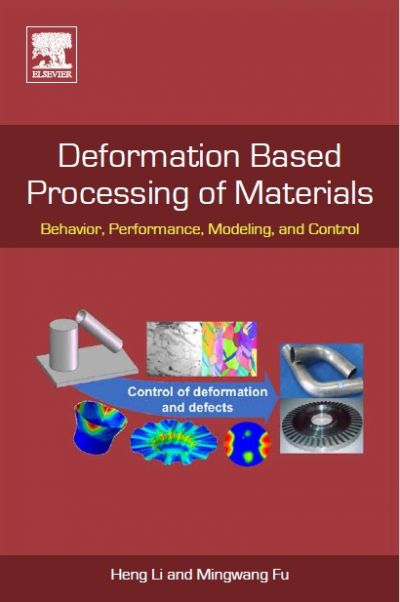
Deformation based processing is one of important enabling manufacturing processes in nowadays’ manufacturing and product development industries for its high productivity, low production cost and unique advantages in shapes and geometries generating and performance tailoring. The parts or components produced by this manufacturing process such as sheet metal and bulk forming are widely used in many industry clusters, ranging from computer, home appliance, medical, consumer electronics, automobile to aerospace industries. It is well recognized that nearly 70% of metallic products are handled by the deformation based processing. The high demand for shorter design and development lead time, lower production cost, better dimensional accuracy and overall forming quality has become the bottleneck issues in current deformation based manufacturing for maintaining and improving the market competitiveness and technological cutting-edge for the companies using this technology for their production.However, non-uniform stress and strain distributions are frequently induced during the deformation based processing of materials. In case the inappropriate thermal-mechanical loading conditions applied, the undesirable deformation such as unstable deformation may occur and induce the higher potential occurrence of various defects along with deformation such as damage/ductile fracture, compressive instabilities and surface roughening, etc. The occurrence of these different types of defects directly affects the behaviour and performance of deformation process and the quality of the deformed parts, which thus greatly limits the development and wide application of deformation based materials processing and manufacturing. In tandem with this, it is the everlasting fundamental issues and challenging problems as well as frontier topics to explore the deformation behaviours and process performance in ways a way to well control deformation, product quality, defect avoidance in this crucial manufacturing area.Currently, there are plenty of publications, including edited books, journal papers, proceedings etc., available on various aspects of deformation based processing from fundamental theory to technology innovation. However, there is still lack of a monograph that systematically and thoroughly addresses the process behaviour, performance, modelling and control with the latest research findings and achievements. The book will summarise state of the art research on deformation based processing of materials and provide a systematic and informative knowledge in this domain specific area for researchers, engineers, students and management professionals in manufacturing arena.
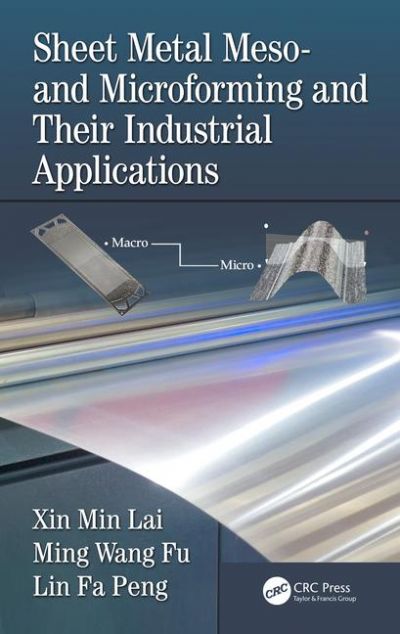
‘Sheet Metal Meso- and Microforming and Their Industrial Applications’ presents state-of-the-art researches on meso- and microforming processes and the needed information and the systematic and holistic knowledge for physical realization of the developed meso- and microforming processes and the tangible and practical applications in fabrication of meso- and micro-scaled metallic sheet-metal parts via sheet-metals meso- and microforming. The applications include fabrication of thin metallic bipolar plates for fuel cells. In tandem with this, the book provides extensive and informative illustrations, tables, case study photos and figures to convey the information and knowledge of sheet-metal meso- and microforming and meso- and micro-scaled sheet-metal products clearly and directly to readers.Sheet metals meso- and microforming refers to the fabrication of meso/micro-scaled sheet metal parts via meso- and microforming of sheet-metals or using sheet-metals as raw material to directly make meso/micro-scaled bulk metal parts. It is well known that the systematic knowledge of the traditional sheet metal forming, the so-called sheet metal macroforming in this book, is well established and widely used many industrial clusters, the same, however, cannot be said to the meso- and microforming as there are still many eluded and tantalized issues in this down-sized scale forming process which need to be further explored and investigated. Recently, plenty of good efforts have been provided to the extensive research in this domain. This book is thus to summarize the latest research outcomes in this area in terms of addressing some critical issues including meso- and microforming process determination, tooling design, product quality assurance and control, and the size-effect affected behaviors and phenomena and applications. This book is intended for research students, manufacturing and product development engineers and professionals working in the areas of manufacturing and materials processing.
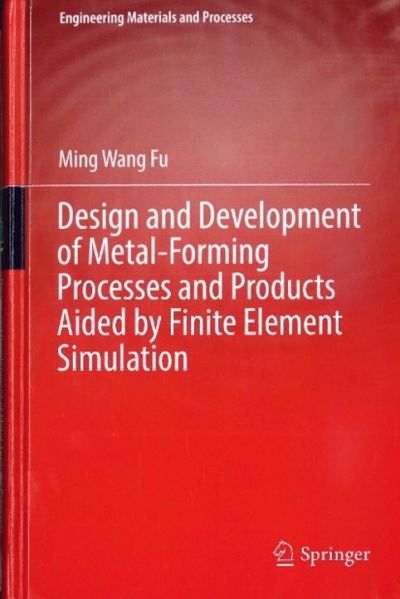
This book presents state-of-the-art research on forming processes and formed metal product development aided by the Finite Element method (FEM). Using extensive and informative illustrations, tables and photographs, it systematically presents real-life case studies and established findings regarding various forming processes and methods aided by FE simulation, and addresses various issues related to metal formed part design, process determination, die design and die service life analysis and prolongation, as well as product quality assurance and improvement.Metal forming has been widely used in many industries. This traditional manufacturing process, however, has long been linked to many years of apprenticeship and skilled craftsmanship, and its conventional design and development paradigm appeared to involve more heuristic know-how and trial-and-error than in-depth scientific calculation, analysis and simulation. The design paradigm for forming processes and metal formed product development thus cannot meet the current demands for short development lead-times, low production costs and high product quality. With the advent of numerical simulation technologies, the design and development of forming processes and metal formed products are carried out with the aid of FE simulation, allowing all the potential design spaces to be identified and evaluated, and the best design to ultimately be determined and implemented. Such a design and development paradigm aims at ensuring “designing right the first time” and reducing the need for trial-and-error in the workshop. This book provides postgraduates, manufacturing engineers and professionals in this field with an in-depth understanding of the design process and sufficient knowledge to support metal formed part design, forming process determination, tooling design, and product quality assurance and control via FE simulation.
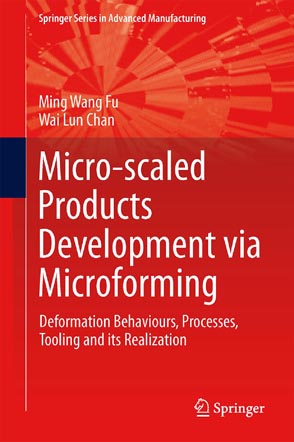
‘Micro-scaled Products Development via Microforming’ presents state-of-the-art research on microforming processes, and focuses on the development of micro-scaled metallic parts by microforming processes. Microforming refers to the fabrication of microparts via micro-scaled plastic deformation and presents a promising micromanufacturing process. When compared to other micromanufacturing processes, microforming offers advantages such as high productivity and good mechanical properties of the deformed microparts. This book provides extensive and informative illustrations, tables and photos in order to convey this information clearly and directly to readers.Although the knowledge of macroforming processes is abundant and widely used in industry, microparts cannot be developed by leveraging the existing knowledge of macroforming because the size effect presents a barrier to this knowledge transfer. A systematic knowledge of microforming thus needs to be developed. In tandem with product miniaturization, the demand on microparts has been increased for their wide applications in many industries, including automotive, bio-medical, aerospace and consumer electronics industries. Micromanufacturing technologies have already become an important and promising manufacturing process. This book is intended for postgraduates, manufacturing engineers and professionals working in the areas of manufacturing and materials processing.
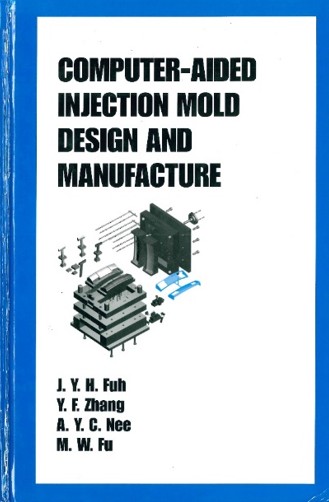
Tool engineering constitutes an important branch of manufacturing engineering as any direct improvement of existing tooling processes or an introduction of novel processes could significantly improve the production efficiency, product quality and reduce design and processing time. This would enhance the competitiveness of a manufacturing company and maintain its leading edge over its competitors. Tooling design is as important a topic as the manufacturing process itself. Without suitable tooling, manufacturing processes are often crippled or rendered totally inefficient. With the increasing use of computer tools and technology, this scenario has changed rapidly since the introduction of CAD/CAM/CAE tools in the early 1980s. It is the authors’ beliefs that CAD/CAM technologies are playing more and more important roles in the tooling industry to shorten the design and manufacturing lead-times.Mould making is an important sector in precision engineering industry since the moulded parts and components represent more than 70% of the consumer products ranging from computers, home appliances, medical devices, to automobiles, etc. While CAD/CAM technologies have found a wide range of applications in the many areas of engineering, its applications to mould design and manufacturing have been relatively limited. This book, containing more than 255 illustrations, is written for the aim of reporting the latest research and the state-of-the-art development achieved in automatic design and manufacture of plastic injection mould (for plastic materials) and casting die (for metallic materials). It is hoped to promote the use of computer-aided injection mould design systems and stimulate greater R&D efforts in this critical area.
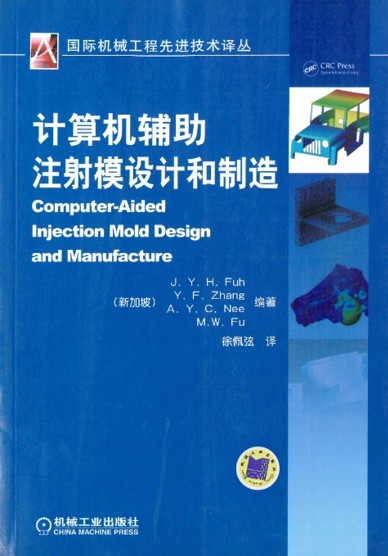
《计算机辅助注射模设计和制造》主要介绍了塑料注射模和金属压铸模计算机辅助设计和制造的最新研究成果,并结合许多工业实例,着重介绍了自动或半自动的计算机辅助注射模设计系统一CADIMDS,不仅阐述了该系统的整套方法,而且介绍了其算法、执行程序和系统结构。书中还深入分析了模具智能化设计和装配,介绍了IMOLD的主要功能和应用情况,以及以UNIX和Windows两者为基础的模具智能化设计系统的研究状况;探索了各种系统的结构和技术,分析了确定影响和强化CADIMDS系统软件的因素;介绍了测算有效成本的各种策略,阐述了在计算机辅助工艺规 (CAPP) 中,对模具零部件制造工艺的专门处理要素。《计算机辅助注射模设计和制造》是作者们经过多年的研究,对模具智能化设计关键技术方面的发展与创新的总结。对从事精密机械工程的开拓者和设计师们来说,《计算机辅助注射模设计和制造》是一本具有很高参考价值的参考资料。





